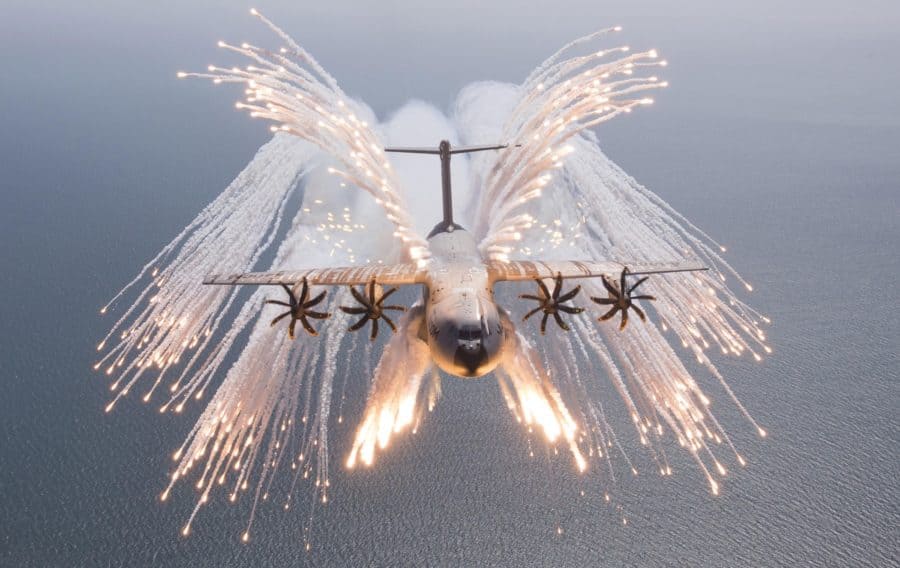
Airbus develops new A400M variant to coordinate drone strikes with Europe’s future sixth-generation fighter jet.
30 Jun, 2025 - 8:26At the 2025 Paris Air Show, Airbus Defence and Space confirmed the development of a new variant of the A400M military transport aircraft to support an expanded range of missions aligned with the operational goals of the Future Combat Air System (FCAS) and the Multi-Domain Combat Cloud (MDCC). The aircraft is being adapted to serve as a broadband communications node capable of linking manned and unmanned platforms across all domains, air, land, sea, space, and cyber.

As part of the Combat Cloud, this new A400M variant will support the transmission of near real-time tactical awareness across multiple platforms, contributing to time-sensitive operational decisions. (Picture source: Airbu

- Airbus indicated that the aircraft will transition from current narrowband systems to broadband satellite communications, allowing it to transmit and receive large volumes of operational data from remote areas.
- In the event of satellite disruption, a line-of-sight system will enable communication with other airborne or ground platforms.
- Therefore, this new A400M variant is intended to function as a key platform within the Future Combat Air System (FCAS)’s distributed command and control architecture.
As part of the Combat Cloud, it will support the transmission of live video from mission areas, contributing to time-sensitive operational decisions. By acting as an airborne data relay, the aircraft will enable sensor fusion and near real-time tactical awareness across multiple platforms. Airbus confirmed that the aircraft could deploy Remote Carriers, perform standoff electronic warfare (EW) missions, and support short-range strike operations using guided bombs or missiles launched from the cargo bay or external hardpoints. Discussions with the French Air and Space Force are underway to explore the viability of a dedicated strike version. In addition, the company is developing roll-on/roll-off kits for aerial firefighting missions capable of delivering up to 20,000 liters of water. These modifications are intended to expand the A400M’s mission set in alignment with FCAS and NATO requirements.
The integration of the A400M into the FCAS programme reflects Airbus’s multi-phase approach to supporting system-of-systems operations.

- This phase includes €600 million in contracts for Spain and involves Dassault, Airbus, Indra, and EUMET.
- Phase 1A concluded in 2022 and covered initial demonstrator planning.
- Phase 2, expected to begin in 2025, will lead to the production and flight testing of demonstrator platforms by 2028 or 2029.
- The MDCC architecture includes end-to-end encryption, distributed analytics, and multi-platform engagement, with data flowing between assets to support decision-making cycles under human supervision. The A400M will serve as one of the nodes in this architecture, both receiving and broadcasting data to enhance force coordination.

- Designed as a tactical and strategic airlifter, the A400M has a maximum payload capacity of 37 tonnes and a range of up to 8,700 kilometers.
- It is powered by four Europrop TP400-D6 turboprop engines producing 11,000 hp each and features counter-rotating propellers on each wing to reduce torque and improve efficiency.
- The aircraft can take off from short, unprepared runways and perform aerial refueling, medical evacuation, and paratroop drop missions.
- Its flight control system is based on fly-by-wire technology with sidestick input, and it includes a glass cockpit, multi-mode radar, and self-protection systems.
The development of the A400M Atlas began in the 1980s under the Future International Military Airlifter (FIMA) group, which evolved into the Euroflag consortium.
Following the selection of the TP400-D6 engine developed by Europrop International, the aircraft experienced delays and cost overruns during its initial phase.
It first flew in December 2009, entered service with France in 2013, and received EASA certification in March 2013. The aircraft has experienced various engineering issues, including propeller gearbox failures and structural fatigue in some aluminum-zinc alloy components.
A number of modifications were introduced between 2010 and 2020, including improved mission systems, fuel transfer capability, cargo handling upgrades, and certification for combined airdrop missions.
- In 2024, the German Air Force tested the A400M’s mixed airdrop configuration with cargo and paratroopers at 220 km/h from 400 meters altitude.
- Airbus confirmed that the aircraft is certified for this configuration and is awaiting full military certification after further data analysis.
- Airbus has stated that the A400M will remain aligned with these milestones, serving as a communications relay and operational enabler for joint missions involving the NGF and Remote Carriers.
- The Combat Cloud will rely on secure satellite constellations for real-time, reconfigurable communications and will integrate ISR data from Eurodrone optical systems, radar, and naval and land-based assets.
- The NGF will be supported by autonomous Remote Carriers operating under human control.
- The A400M, with its ability to launch such carriers and maintain long-range communications, will contribute to this system-of-systems approach.
- Airbus confirmed that the aircraft’s large payload capacity, power generation, and cabin volume provide sufficient space and flexibility for future upgrades related to electronic warfare, cloud computing modules, and modular mission kits.

With the confirmation of this new variant, the A400M becomes an integral part of Europe’s long-term airpower strategy. As FCAS development continues under the joint leadership of Dassault, Airbus, and Indra, and as Phase 2 of the programme approaches, the aircraft’s integration into the MDCC is intended to provide cross-domain resilience and coordination. Airbus has stated that the A400M’s evolution is consistent with NATO’s C3 standards and that ongoing work on collaborative engagement, cyber protection, and AI-supported targeting will continue in cooperation with industrial and governmental stakeholders. The aircraft is positioned to remain in service beyond 2040, supporting both conventional missions and future digital warfare scenarios. The integration of the A400M into FCAS marks a shift from its original role as a logistics aircraft toward a broader function as a multi-role enabler in the digital battlespace.



No comments:
Post a Comment